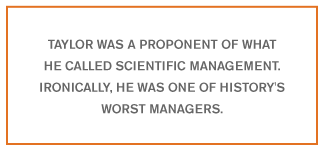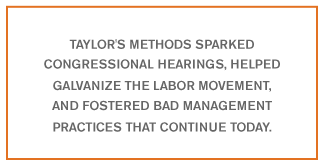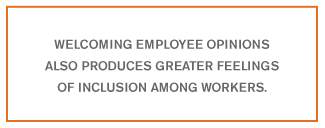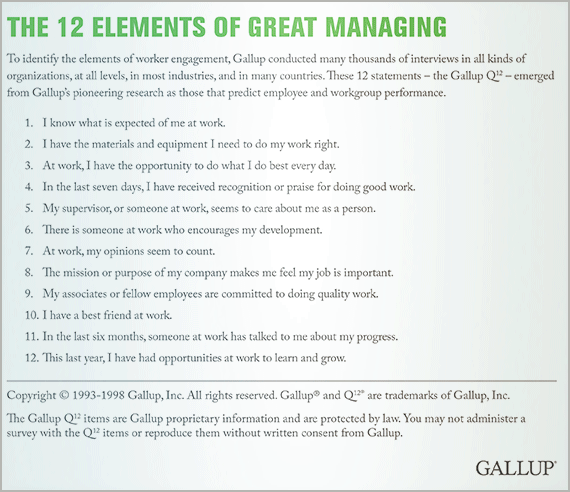By all accounts, Henry Noll was a good worker.
He would walk home after a 10-hour day at a brisk pace "about as fresh as he was when he came trotting down to work in the morning." He was frugal -- one of his coworkers said, "A penny looks about the size of a cart wheel to him" -- saving enough of the $1.15 per day he earned in 1899 to buy a small plot of land. Before and after his shift at Bethlehem Iron Company in Pennsylvania, he worked on constructing the walls of a small one-and-a-half-story clapboard house.
 |
He was not a large man, only 135 pounds, but he was strong and athletic. He had worked three years at Bethlehem when he was discovered and eventually made famous by Frederick Winslow Taylor.
Taylor was a proponent of what he called "scientific management." Ironically, he was one of history's worst managers. By not only ignoring the views of workers like Noll, but even mocking their worthiness to have an opinion about their own efforts, Taylor taught -- by contrast -- the importance of the Seventh Element of Great Managing. The element is measured by the statement "At work, my opinions seem to count."
Although the son of a wealthy family, Taylor apprenticed in a machine shop. He was endlessly experimenting with improving processes, particularly with lathes, metallurgy, and the tools used to cut the metal. Taylor was obsessed with output -- how to help employees "do their work in the best way and in the quickest time." In 1899, he turned his attention to the problem of 80,000 tons of "pig iron" sitting in a yard east of the iron mill and tried to apply to human productivity the scientific approach he previously used on mechanical workings.
Each 92-pound block or "pig" of iron had to be lifted, carried across wooden planks to the railcar, and handed to another man stacking them in place. The usual rate of loading was 12½ tons per man in a 10-hour day. Taylor estimated that a "first-class" worker could load 45 tons per day.
Why would anyone work at a pace twice to three times what laborers had averaged? In his utopian view, Taylor assumed it was simply a matter of higher pay for harder work and persuading workers to leave the thinking to a group of methodical overseers using Taylor's methods. "The development of a science (of managing tasks) involves the establishment of many rules, laws, and formulae which replace the judgment of the individual workman and which can be effectively used only after having been systematically recorded, indexed, etc.," he wrote.
Such grueling work
Right from the beginning, there were problems. When paid by the day, workers made about $1.15. A worker could earn $1.69 if he hit the supposedly attainable 45-ton mark, but that would mean lifting almost 1,000 pigs during his shift, almost 100 an hour. Ten men who agreed to try piecework changed their minds and went back to the day-rate crew. Taylor saw to it they were fired. Seven more men were recruited. Only five reported for work. One of them was Henry Noll.
The five men averaged 32 tons each that day, but two more dropped out. Noll's coworkers moved between 35 and 40 tons each. Noll did 45¾, earning $1.71. Very soon, only Noll remained. Noll became Taylor's poster child. The efficiency expert claimed that his worker wasn't unusual -- that many workers who weren't "soldiering" or failing to follow orders could equal his output. But the engineer certainly didn't think much of his ideal worker's intellect, as shown by Taylor's recollection of his directions to Noll on how he could earn higher pay.
"If you are a high-priced man," Taylor said, "you will do exactly as this man tells you tomorrow, from morning 'til night. When he tells you to pick up a pig and walk, you pick it up and you walk, and when he tells you to sit down and rest, you sit down. You do that right straight through the day. And what's more, no back talk. Now, a high-priced man does just what he's told to do, and no back talk. Do you understand that?"
The roots of "Taylorism"
Because of his jaundiced view of workers' opinions about their own work, Taylor spawned "Taylorism," a pejorative used to describe the treatment of men as unthinking machines. Taylor's methods sparked congressional hearings, helped galvanize the labor movement he thought would be unnecessary with his approach, and fostered bad management practices that continue today.
"Scientific management was degrading," wrote Taylor biographer Robert Kanigel. "In reducing work to instructions and rules, it took away your knowledge and skill. In standing over you with a stopwatch, peering at you, measuring you, rating you, it treated you like a side of beef. You weren't supposed to think. Whatever workmanly pride you might once have possessed must be sacrificed on the altar of efficiency, your role only to execute the will of other men paid to think for you. You were a drone, fit only for taking orders. Scientific management, then, worked people with scant regard not only for the limitations of their bodies but for the capacities of their minds." And as if he had not insulted Noll enough in his conversations with him and his descriptions in print, Taylor went one further. Instead of using his real name, he called him simply "Schmidt."
 |
Taylor's ghost haunts the way many companies still do business. One company had the same experts who designed its computer systems write protocols for interacting with customers. The inch-thick manuals described in Tayloresque detail and flow-charted steps how the employee should behave and how the customer should react, including a five-minute limit on the interaction itself.
Call centers frequently keep a stopwatch on their telephone representatives. Banks keep scorecards on functional process steps that are as easily observed as they can be meaningless when delivered without emotion. A few companies even try to dictate to their workgroups which of the 12 Elements of Great Managing to work on each month of the year -- the First Element in January, the Second in February, and so forth -- making July particularly rich in irony as the month when company higher-ups command employees to work on how to make their opinions count.
Airlines, arguably among the worst offenders, routinely lock passengers in with a crew of Schmidts reading from a script and processing passengers like Bethlehem workers moving pig iron. The experience of one frequent flier shows the direct connection between employee feelings of empowerment and the quality of customer service.
"Do you have any hot chocolate?" asked the passenger when the attendant and her beverage cart reached his aisle.
"Not even," she said with a contemptuous look.
"How about some orange juice?"
The flight attendant nodded and began pouring the juice. While she did, the passenger pressed the question. "I don't understand why this airline doesn't keep some packets of hot chocolate on board," he said. "They store easily. They're easier to make than the coffee you have to make fresh."
"We used to have some," said the attendant, handing the passenger his plastic cup of juice. "Maybe all the flight attendants drank it. Don't ask me. My opinion isn't worth a lot around here."
Bringing out creative ideas
Millions of these small interactions establish a company's reputation much more than their stated aspirations, which in this case included "Always put customers first" and "Always strive to improve." When Gallup conducted an exploratory survey using a new customer engagement metric a few months later, it was no shock to find that the airline, Northwest, scored near the bottom of the heap. Nor was it startling to find that the stock performance of the airlines with higher customer engagement, such as Southwest, performed better after the tragedies of 9/11 than those without the same reserve of goodwill.
The mechanism that connects this element with better business performance appears to be a greater sense of responsibility for those things over which one has a say. No matter how strong the external incentives, they never seem to measure up to the internal drive of advancing something that is at least partially one's own idea. Nearly half of employees who say their opinions count at work also feel that their current job brings out their most creative ideas. Among those who are neutral or negative on the Seventh Element, only 8% feel like their creativity is well employed.
In this element, as with all 12, many modest, discretionary actions by employees create meaningful differences in the enterprise's metrics. For example, when manufacturing plants in one large organization were ranked by their scores on the "opinions count" statement, those in the top quartile averaged one in three employees strongly agreeing, while plants in the bottom quartile averaged only one in seven. And, accidents were more than twice as likely to occur in the bottom-quartile plants as they were in the top-quartile plants.
On a larger scale, improving the proportion of employees with high Seventh Element scores from one in five to one in three has a substantial impact on customer experience, productivity, employee retention, and safety -- all of which create, on average, a 6% gain in profitability.
Incorporating employee ideas pays back twice. First, the idea itself often is a good one. Second and equally powerful, because the idea comes from the employees themselves, it is much more likely that they will be committed to its execution. Welcoming employee opinions also produces greater feelings of inclusion among workers. When the 12 elements are compared against a number of statements testing perceived racial or gender bias, the "opinions count" statement is most highly correlated with feelings that employees are always treated with respect, that the company treats its workforce fairly.
 |
More than a century after Taylor and Noll met, and less than 200 miles away, two professors took on the same problem of how to best increase productivity. Derek Jones and Takao Kato went to a small manufacturing facility in central New York to investigate whether inviting employees to share their opinions about process improvements created the hoped-for benefits.
The real name of the company was not revealed. In their paper, Jones and Kato called it "PARTS." PARTS was a subsidiary of a multi-national company. It made a range of small components used by large manufacturers. Its customers demanded high quality, so the 134 machine operators it employed had to be careful to not deviate from design specifications. Pieces outside those tolerances were rejected.
The parallels to the problems Taylor sought to solve are intriguing. Like Taylor, Jones and Kato were studying a manufacturing environment. Like Taylor in his experiments with lathes and metal, the professors were investigating how man and machine (or woman and machine; 62% of PARTS operators were female) can combine for maximum production. Like Taylor, Jones and Kato were studying the productivity of low-wage workers. Only one-third of PARTS operators had education beyond high school, and virtually none had a four-year college degree. The average wage was $7.64 an hour.
Beyond the advances in technology during the century that separates them, the major difference between the studies is that while Taylor wanted a mindless compliance with management's thinking, PARTS executives were inviting workers to strategize on the best ways to improve the work with which they were so familiar. For example, the 400-square-foot shipping area "was originally quite disorganized, and access to the shipping area was cumbersome at best," wrote Jones and Kato. "A team reorganized this shipping area and thereby created additional free space equaling 175 square feet. In turn, this allowed workers at all stations to access the shipping area quickly and smoothly."
Operators developed a new labeling system for spare parts, reducing both the time needed for labeling and defects caused by using wrong parts. Employees developed a better exhaust system for the wire soldering station, revised manuals, and rearranged machine locations for better efficiency.
PARTS provided a good environment for studying employee input because at the time of the research, only some of the employees were eligible to participate in the new operator-input "team" program. The professors interviewed 90% of the operators face-to-face and were able to compare the comments of those who were in and out of the initiative. "Relative to non-team members, team participants consider themselves to be more empowered, sensed that more information was being shared by management, communicated more often with managers and supervisors within their work groups or teams, and communicated more often with workers outside of their work groups or teams," wrote the researchers.
"In addition, the survey findings indicate that participants in teams put more effort into their work. The evidence is equally suggestive that attitudes and thus potentially the behavior of team members was being affected in other ways. Thus we find some evidence for participants displaying stronger organizational commitment and more trust towards management. . . . Team members are more satisfied with their jobs (and) are more positive about the use and contributions of their knowledge and skills."
The New York manufacturer was also a good site for research because the company keeps individual statistics on each operator's production, defect rate, and downtime. Employees in the "team" program averaged 3% higher production and 27% fewer defects. While the company had to invest additional time to gather input, the results bolster the case that "employee involvement will produce improved enterprise performance through diverse channels, including enhanced discretionary effort by employees."
Somewhere beyond the grave, Henry Noll is smiling.
 |